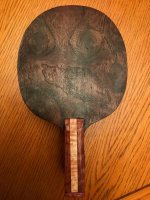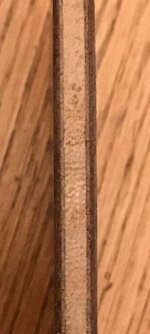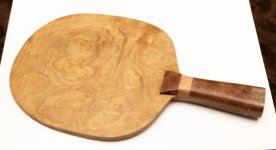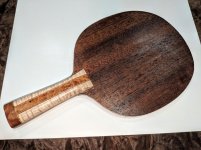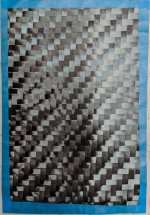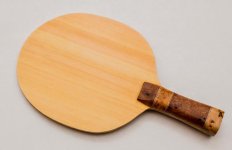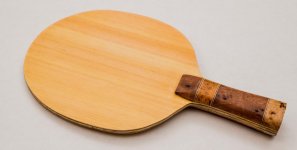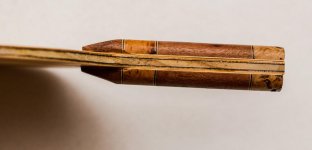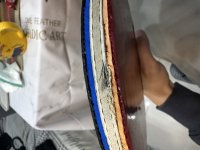View attachment 16809
This is the latest blade in my journey. While working on the handles for the ZLC blade, I started making another, but this time from one of the other carbons I purchased.
The composition of this blade is: Mahogany - Hexcel Primetex 12K ST Carbon - Black Limba - Kiri - Black Limba - Hexcel Primetex 12K ST Carbon - Mahogany.
Handle is made from Curly Maple, with a center stripe of Ambonya, and some Pomelle Sapele for the end cap. I used Okoume and Mahogany veneer stripes on either side of the Ambonya to set it off from the Maple, and then Pine veneer strips to set the End cap off from the rest of the handle. I really like how it turned out... the little color variations on the pine veneer and the contrast of the okoume against the Ambonya and then the mahogany against the maple. It just came together really nicely I think.
The ply orientation is a bit interesting in this one as well. Mahogany at 0, Carbon (Not sure orientation matters here, as the pattern doesn't have a particular "direction" to it that I can tell), Limba at 0, Kiri core at 90 degrees... So the core will flex a lot, but the plies are stiff, with a stiff carbon fiber
I originally purchased 3 different carbons. A regular 2x2 twill ZLC carbon, a spread tow Textreme ZLC carbon, and then the carbon in this blade which I found rather interesting. It is called a 2x2 twill Hexcel PrimeTex 12K spread tow carbon fiber. What that means is the carbon fiber is arranged 2x2 twill pattern, it is weaved from thicker individual strands of carbon (spread tow), the yarn size is 12000 carbon filaments per "tow". 12K carbon fiber is quite heavy normally... The reason I chose this fiber was because, in a spread-tow, the weight actually becomes manageable (192gsm) and I wanted to give it a try. Generally the higher the weave count, also the stiffer the carbon fiber is as well.
This blade was an interesting journey and I ran into a few issues that I now know better how to solve. In particular spread tow carbon fibers are easy to malform, as the individual tows are literally just woven together...so you can easily pully a strand out of the weave without much effort at all. This was very apparent when applying resin. I was using a metal spreader that i'd used many times for spreading Polyurethane glue, and it works great. However it was no longer perfectly smooth, having a few tiny bits of glue left on it from a prior cleaning, and those caught on the carbon fiber tows and made spreading a very tricky task. I purchased a roller for future resin applications. Also, due to this difficulty I believe I applied way too much resin. This left me with a blade that was 79g+ before even adding handles. I was able to bake it down to 77.5g, but that still left a major challenge. I decided to take a millimeter or two off the top area of the blade (so instead of 150x157mm, its closer to 150x155-156mm, and then with handles that were 10-10.5g each, the weight of the blade after gluing the handles and applying finish ended up being 96.4g. A little heavy, but i've found during my blade creation journey that a well balanced 93-96g blade feels just as good to me as a 85-87g blade.
